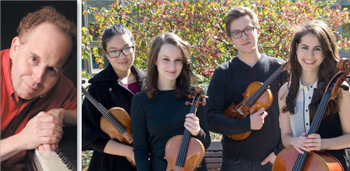by Daniel Hathaway

Fortunately, ART artistic director Christine Haff-Paluck had the rich resources of the Cleveland Institute of Music to draw upon, and organized a replacement quartet of excellent players: violinists Jinjoo Cho and James Thompson, violist Leah Ferguson and cellist Catlyn Kessler.
Then came the piano issue. Shapiro needed a more powerful instrument than the resident piano for a program of Romantic piano quintets, so a Steinway B was graciously loaned for the occasion from the Oberlin Conservatory.
And then there was a change in the program order after the programs had been printed: Dvořák’s Quintet in A, op. 81 was to have begun the concert, with Franck’s Quintet in f to follow. Haff announced before the concert that the two pieces would be played in reverse order.
All’s well that ends well — and it was a boon on a gray, unsettled November afternoon to be sent away with the cheerful tones of Dvořák in your ears rather than the expressive but distinctly brooding music of César Franck. A large audience turned out for the performance and were rewarded with intelligent and finely wrought playing of two substantial chamber works.
Though ART’s printed programs provide extensive biographies of performers, they offer little information about the music being played. No matter how you feel about program notes, a few pieces of background information about the works might be welcome and help to establish context.
Sunday’s Franck and Dvořák couldn’t be more different in tone and compositional approach, though they were written only a decade apart (the Franck in 1878-1879, the Dvorak in 1887). Franck was fundamentally influenced by Wagner’s chromatic harmony — to the point where his advice to students was “always modulate” (a trait that so alienated Camille Saint-Saëns, the quintet’s dedicatee and the pianist at its premiere, that he stormed offstage afterward and refused to have the score presented to him). Thus the quintet’s writhing, hyper-emotional language stems from its restless harmonic underpinnings.
Dvořák, on the other hand, seems to have distilled the essence of the Bohemian countryside and poured its wholesome naturalness into his works, building their themes out of made-up, folk-inspired melodies and never allowing a dark thought to penetrate too deeply, even in the dumka (lament) that forms the second movement of this piano quintet. He also gave considerable prominence to his own instrument, the viola, no doubt to the delight of Leah Ferguson, who brought a warm, lyrical tone to her several solos.
The Franck begins with an unusual conversation between strings and piano — a back-and-forth colloquy with contrasting material that returns later in the movement. When the strings join the piano, an emotionally intense journey begins and barely lets up through the work’s three movements. Shapiro and the string quartet played with a fine sense of ensemble, though one wished for more presence from the keyboard in places and more of a sense of line from the strings in the craggy opening figure. James Thompson set up the nervous ambiance of the finale beautifully with his strong statement of its pulsing, opening theme.
Though strings occasionally overbalanced the piano in the Dvořák, the players found the soul of the music and put it across beautifully. It was a gamble programming these two challenging pieces with a pickup group after an well-established quartet withdrew, but Cho, Thompson, Ferguson and Kessler rose to the task and easily upheld the high artistic standards of the ART concert series.
Published on ClevelandClassical.com November 22, 2013
Click here for a printable version of this article.



